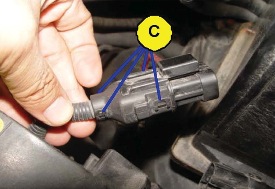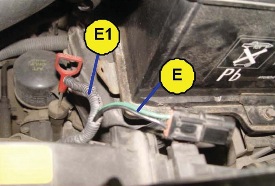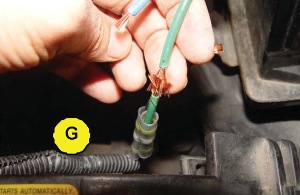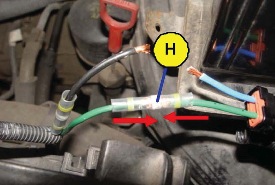A replacement connector is available for the radiator fan connector (E25). This bulletin provides the procedure to replace the radiator fan motor connector with the replacement connector.
• Some Santa Fe (SM) vehicles may exhibit an overheating engine and inoperative A/C.
• Inspection of the radiator fan connection reveals it’s abnormal.
• Repair action of this TSB is to replace the incident radiator fan motor connector with the new connector of the parts kit by following the Service Procedure below.
Applicable vehicles: 2004-’06 Santa Fe
Parts Information/Components of Kit:
• Connector & Wire Kit — 91200-26000FFF
• Radiator Fan Side Connector and Wire — 25387-26000FFF
• Radiator Fan Harness Side Connector and Wire — 91201-26000FFF
• Solder Sleeve Tube — CWT-9004
Service Procedure:
1. Disconnect the negative battery cable from the battery post.
2. Disconnect the radiator fan connector.
3. Pull away the wiring fixed to the radiator fan shroud.
4. Open the fan motor side connector cover by releasing four cover locks (C). See Fig. 1.

5. Remove the connector cover (C1).
6. Using a cutter, vertically cut the corrugated tube (D) 120 mm (4.7 in.) from the end of the connector.
7. Partially remove the cut corrugated tube (E1) from the wire (E). See Fig. 2.
8. Cut off the black wire 30 mm (1.2 in.) and the green wire 50 mm (2.0 in.) from the end of the connector. Discard the connector.

9. Strip the wire coverings 8 mm (0.3 in.) from the cut ends.
Caution: Be careful not to damage the wires.
10. Insert the stripped wires into the solder sleeve tubes.
11. Overlap the green wires by squeezing them into each other; do not twist them. Place the solder sleeve tube (G) over the overlapped wires. See Fig. 3.

12. Align the solder part (H) of the solder sleeve tube with the center of the overlapped wires. See Fig. 4.

Caution: Make sure to keep the stripped wires overlapped by holding them with both hands.
13. Subject the solder part to heat. Once the solder is melted, evenly heat the entire solder.
14. After the solder part is melted completely, wait approximately 10 seconds until the solder sleeve tube becomes cold. Pull both ends of the solder sleeve tube outside slightly, then subject both ends of the solder sleeve tube to heat.
15. Apply the above procedures (step 11 to 14) to the black wire.
16. Insert the wires of the new fan motor side connector into the cut corrugated tube, then tape the cut corrugated tube and install the connector cover.
17. Apply the above procedures (step 4 to 15) to the fan motor harness side connector.
18. Fix the fan motor side connector to the fan shroud, then connect it to the fan motor harness side connector.
19. Reconnect the battery cable to the negative terminal of the battery.
20. With the engine running at idle, turn on the A/C or defroster and verify that the cooling fan connection was repaired properly. The cooling fan should come on.
Courtesy of ALLDATA.













